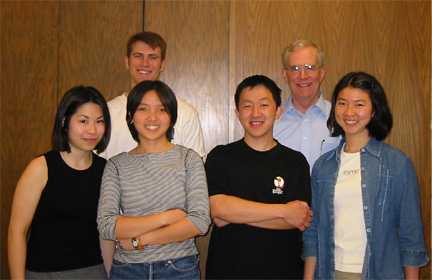
See our results for pressure drop in microdevices and our Web lessons. These are all for laminar flow, especially for low Reynolds number as would be appropriate in small devices.
Some sample results from the 2002-2003 school year are available: Demonstration. More detailed results are not provided since some of them will be submitted for publication or they involve working with companies.
The Autumn quarter results, 2002, include correcting an error in the literature regarding the role of the thickness of an orifice, in small devices (Febe Kusmanto), developing correlations for the pressure drop at low flow rates in curve pipes (Michael Harrison), looking at dispersion in a complicated 3D device (Zachery Tyree), and solving for the two-dimensional flow of ferrofluids in pipes (Colin Reese).
The spring quarter 2002 results include the effect of viscosity depending on concentration (Marlina Lukman), mixing in a particular microreactor (Albert Witarsa), correlating pressure drops in a T-sensor so that one can predict the effects without simulating the whole phenomena (Won Ng), and correcting an error in the literature regarding the role of the thickness of an orifice, in small devices (Febe Kusmanto).

Picture of Research Group, Spring, 2002
Won, Kris, Marlina, Albert, Bruce, Febe
Picture of Research Group, Winter, 2002
Bruce, Haijun, Kris, Marlina, Trevor, Albert
Results for winter quarter include correlating pressure drops in complicated 3D devices (Marlina Lukman) and contractions (Albert Witarsa), and correlations of approach length for contraction flows (Trevor Plaisted).
These results show the beginning steps in learning to do the calculations.
This project began by developing correlations for pressure drop in bends and turns, but limited to 2D flows. These results formed the basis for beginning the other projects done later, and we are indebted to Suwimol Kunaridtipol for her excellent work in Spring, 2001.
Also, see the microfluidic calculations done in a beginning graduate fluid mechanics class, Winter, 2002.
The microchemical reactor is to oxidize ammonia to form nitric acid. The multimedia part is to present a story on the subject: "Transport Effects in a Microchemical Reactor", using as a sample the ammonia oxidation reactor. We considered convection and reaction, pressure drop, heat generation, heat transfer in the solid, the entry region, and flow distribution. Two versions are available, one a story that a beginning or junior chemical engineering student can understand, with technical details, and the other one a story that a high school student can understand (these are sometimes combined, with appropriate links). Work was done in groups of four or five. The basis of the story was the weekly assignments, plus equations, pictures, movies, or sound, links to elsewhere, etc. For the technical story, the lesson should show the kinds of problems engineers have to solve. For the non-technical story, the lesson should downplay the differential equations, but try to get across the objectives that engineers deal with when solving those equations. For each story, think through what the person is likely to know, and what you would like them to learn, before deciding what you need to tell them.


![]()
The overall goal of the course is to teach students how to check their computer results to be sure they've solved the right problem and to say how accurately they have done so. The students enrolled were juniors, seniors, and graduate students from the Departments of Chemical Engineering, Bioengineering, and Chemistry. The main software packages used were MATLAB (from Mathworks, Inc.) and FIDAP (from Fluent, Inc.). The later is a CFD (Computational Fluid Dynamics) code, and both codes are used in industry. Naturally, in a ten-week course it isn't possible to do everything one would like, but the lessons are quite interesting and worth reading. I hope you enjoy them. (Bruce A. Finlayson)
Other student-generated Web Lessons